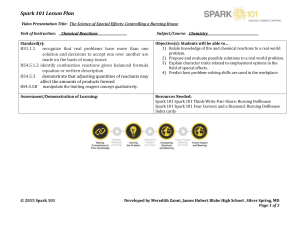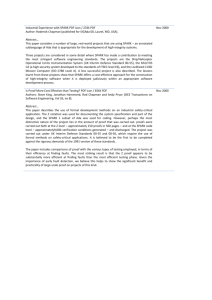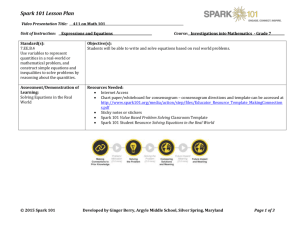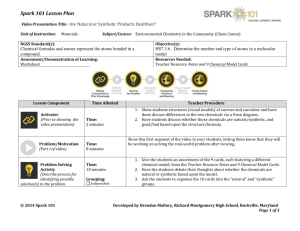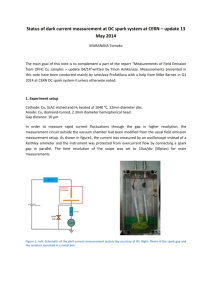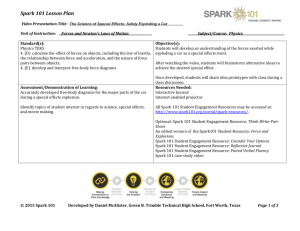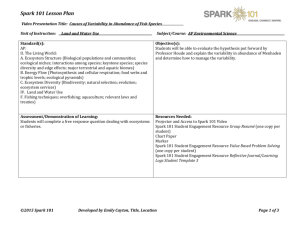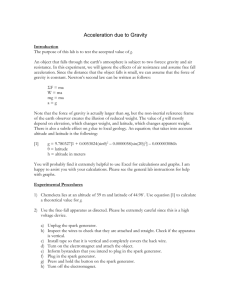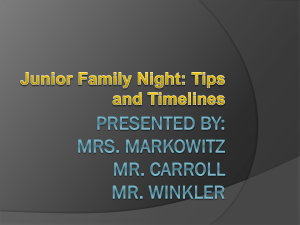Spark 101 Burning House ES Sci TEKS Lesson Plan
advertisement
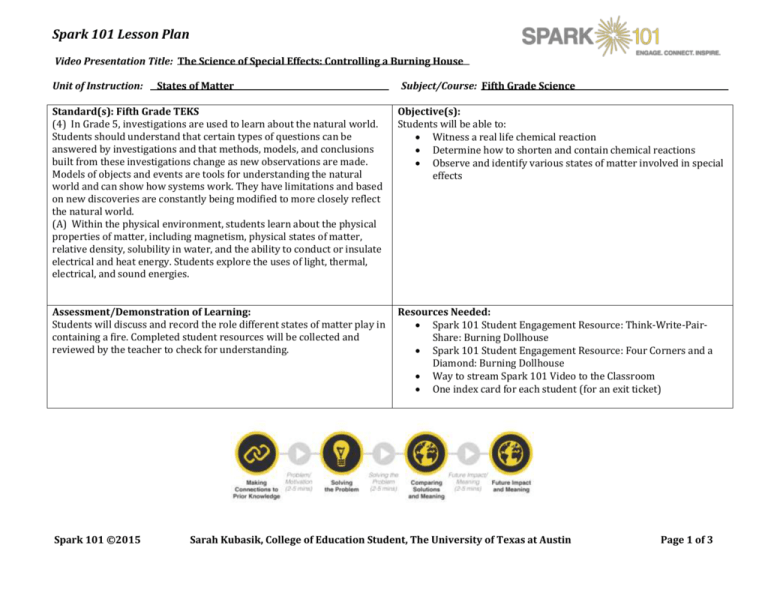
Spark 101 Lesson Plan Video Presentation Title: The Science of Special Effects: Controlling a Burning House Unit of Instruction: States of Matter Subject/Course: Fifth Grade Science Standard(s): Fifth Grade TEKS (4) In Grade 5, investigations are used to learn about the natural world. Students should understand that certain types of questions can be answered by investigations and that methods, models, and conclusions built from these investigations change as new observations are made. Models of objects and events are tools for understanding the natural world and can show how systems work. They have limitations and based on new discoveries are constantly being modified to more closely reflect the natural world. (A) Within the physical environment, students learn about the physical properties of matter, including magnetism, physical states of matter, relative density, solubility in water, and the ability to conduct or insulate electrical and heat energy. Students explore the uses of light, thermal, electrical, and sound energies. Objective(s): Students will be able to: Witness a real life chemical reaction Determine how to shorten and contain chemical reactions Observe and identify various states of matter involved in special effects Assessment/Demonstration of Learning: Students will discuss and record the role different states of matter play in containing a fire. Completed student resources will be collected and reviewed by the teacher to check for understanding. Resources Needed: Spark 101 Student Engagement Resource: Think-Write-PairShare: Burning Dollhouse Spark 101 Student Engagement Resource: Four Corners and a Diamond: Burning Dollhouse Way to stream Spark 101 Video to the Classroom One index card for each student (for an exit ticket) Spark 101 ©2015 Sarah Kubasik, College of Education Student, The University of Texas at Austin Page 1 of 3 Lesson Component Time Allotted Activator (Prior to showing the video presentation) Time: 10 minutes Problem/Motivation (Part I of video) Time: 5 minutes Problem Solving Activity (Describe process for identifying possible solution(s) to the problem presented) Solving the Problem (Part II of video) Comparing Solutions and Meaning (Describe process for identifying possible solution(s) to the problem presented) Spark 101 ©2015 Pairs Time: 15 minutes Grouping: Independent Pairs Small groups (3-5) Whole group Time: 5 minutes Time: 5 minutes Grouping: Independent Pairs Small groups (3-5) Whole group Teacher Procedure Tell students today we are going to be learning about special effects we see on TV, particularly fire. Have the students work in pairs to complete the Spark 101 Student Engagement Resource: Think-Write-Pair-Share to determine what they already know about fire. Show this first segment of the video to your students, letting them know that they will be working on solving the real-world problem after viewing. Ask your students, “How would you create a burning dollhouse that lasts 30 seconds?” Then have your students discuss in small groups as they complete the Spark 101 Student Engagement Resource: 4 Corners and a Diamond - afterwards coming together for a class discussion to share their solutions. Have students briefly state which method (between their small group and full class discussion) they think is best for containing the fire. They should then indicate which state of matter is the most important in the solution they chose. (Ex. using water to put out the fire- liquid) Checks for Understanding Have the students work in small groups to complete the Spark 101 Student Engagement Resource: 4 Corners and a Diamond. As the students work, circle the classroom to provide assistance. After students are finished in small groups come together as a class to hear what solutions the other groups determined. Collect completed resources sheets at the end of class to check for completion and solutions. Show this second segment of the video to your students, letting them know that they will be comparing their solutions to the actual solution shared by the industry professional(s). Have students turn to a partner and discuss which state of matter the professional thought was the most important for controlling the time that the fire burned. Ask them, “How did that compare to the solution that you generated?” Conduct a whole-group question and answer time to clarify any content that students did not understand. Checks for Understanding Circle the classroom and stop in on several pairs to hear what they are saying. Check for understanding during the question and answer period. Sarah Kubasik, College of Education Student, The University of Texas at Austin Page 2 of 3 Future Impact and Meaning (Part III of video) Time: 2 Future Impact and Meaning (Have students reflect on how solving the problem might relate to current or future goals) Time: 3 minutes Summarizer/Closure Time: 5 minutes Grouping: Independent Pairs Small groups (3-5) Whole group Show this third and final segment of the video to your students, letting them know that they will be reflecting on their thoughts related to pursing possible education pathways and careers presented in the video. Class discussion: Ask the students questions such as, “What did the presenter say were the most important character traits for this field? Do we think this is just for special effects or for the work place in general? Where else are these traits important?” (Our classroom) Checks for Understanding Involve a variety of students in the class discussion; ensure the engagement of those who have not spoken yet. Have students complete an index card as an exit ticket, answering these two questions: 1. Would they want to work with special effects? Why or why not? 2. Give an example of a state of matter shown in the video. Why was it important? Collect all student engagement resource sheets and index cards. Check each resource sheet for completion and accuracy. Ensure that the method they used to put out the fire corresponds with the state of matter they said was most important. Check index cards for reasoning and completion of #1 and for a reasonable response about the state of matter for #2. This lesson should occur after the states of matter have been explained, defined and reviewed in a previous lesson. This lesson will take place later in the unit, once students have a basic understanding of the content. Assessment (if applicable) Additional Notes (if needed) CK12 Connections (if available) OpenStax Connections (if available) Access additional free videos, practice, and lessons at: http://www.ck12.org/physical-science/States-of-Matter-in-PhysicalScience/ Spark 101 ©2015 Sarah Kubasik, College of Education Student, The University of Texas at Austin Page 3 of 3
